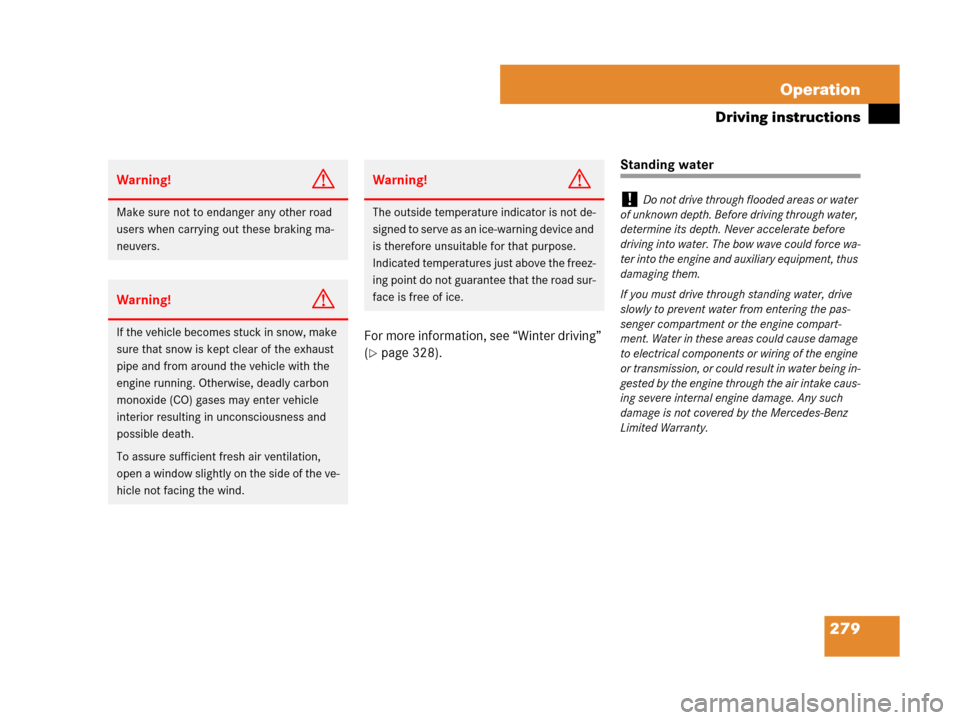Page 66 of 481

65 Safety and Security
Occupant safety
Warning!G
Modifications to or work improperly con-
ducted on restraint systems (such as seat
belts and anchors, Emergency Tensioning
Devices, seat belt force limiters or air bags)
or their wiring, as well as tampering with in-
terconnected electronic systems, can lead
to the restraint systems no longer function-
ing as intended.
Air bags or Emergency Tensioning Devices,
for example, could deploy inadvertently or
fail to deploy in accidents although the de-
celeration threshold for air bag deployment
is exceeded. Therefore, never modify the re-
straint systems. Do not tamper with elec-
tronic components or their software.
Warning!G
In the event that the 1 indicator lamp
comes on during driving or does not come
on at all, the SRS self-check has detected a
malfunction. For your safety, we strongly
recommend that you contact an authorized
Mercedes-Benz Center immediately to have
the system checked; otherwise the SRS may
not be activated when needed in an acci-
dent, which could result in serious or fatal
injury, or it might deploy unexpectedly and
unnecessarily which could also result in
injury.
In addition, improper repair work on the SRS
creates a risk of rendering the SRS inopera-
tive or causing unintended air bag deploy-
ment. Work on the SRS must therefore only
be performed by qualified technicians. Con-
tact an authorized Mercedes-Benz Center.
If it is necessary to modify an air bag system
to accommodate a person with disabilities,
contact your local authorized
Mercedes-Benz Center or call our Customer
Assistance Center at 1-800-FOR-MERCedes
(1-800-367-6372) for details.
Page 69 of 481

68 Safety and Security
Occupant safety
Safety guidelines for the seat belt,
Emergency Tensioning Device and
air bagiAir bags are designed to activate only in cer-
tain frontal impacts (front air bags, driver-side
knee bag), side impacts (side impact and window
curtain air bags) which exceed preset thresholds
and in certain rollovers (window curtain
air bags). Only during these events will they pro-
vide their supplemental protection.
The driver and passenger should always wear
their seat belts. Otherwise it is not possible for
the air bags to provide their supplemental pro-
tection.
In case of other types of impacts and impacts be-
low air bag deployment thresholds, air bags will
not be deployed. The driver and passenger will
then be protected to the extent possible by a
properly fastened seat belt. A properly fastened
seat belt is also needed to provide the best pro-
tection in a rollover.
We caution you not to rely on the presence of the
air bags in order to avoid wearing your seat belt.
It is important to your safety and that of your pas-
sengers that you replace deployed air bags and
repair any malfunctioning air bags to make sure
that the vehicle will continue to provide supple-
mental crash protection for occupants.
Warning!G
�Damaged seat belts or seat belts that
were highly stressed in an accident
must be replaced and their anchoring
points must also be checked. Use only
seat belts installed or supplied by an au-
thorized Mercedes-Benz Center.
�Air bags and Emergency Tensioning
Devices (ETDs) contain Perchlorate ma-
terial, which may require special han-
dling and regard for the environment.
Check with your local government’s dis-
posal guidelines. California residents,
see http://www.dtsc.ca.gov/Hazard-
ousWaste/Perchlorate/index.cfm.
�Air bags and Emergency Tensioning De-
vices (ETDs) are designed to function on
a one-time-only basis. An air bag or ETD
that was activated must be replaced.
�No modifications of any kind may be
made to any components or wiring of
the SRS. This includes changing or re-
moving any component or part of the
SRS, the installation of additional trim
material, badges etc. over the steering
wheel hub, front passenger front air bag
cover, outboard sides of the front seat
backrests, door trim panels, or door
frame trims, and installation of addition-
al electrical/electronic equipment on or
near SRS components and wiring. Keep
area between air bags and occupants
free from objects (e.g. packages, purs-
es, umbrellas, etc.).
�Do not pass seat belts over sharp edges.
They could tear.
�Do not make any modification that could
change the effectiveness of the seat
belts.
�Do not bleach or dye seat belts as this
may severely weaken them. In a crash
they may not be able to provide ade-
quate protection.
Page 280 of 481

279 Operation
Driving instructions
For more information, see “Winter driving”
(
�page 328).
Standing water
Warning!G
Make sure not to endanger any other road
users when carrying out these braking ma-
neuvers.
Warning!G
If the vehicle becomes stuck in snow, make
sure that snow is kept clear of the exhaust
pipe and from around the vehicle with the
engine running. Otherwise, deadly carbon
monoxide (CO) gases may enter vehicle
interior resulting in unconsciousness and
possible death.
To assure sufficient fresh air ventilation,
open a window slightly on the side of the ve-
hicle not facing the wind.
Warning!G
The outside temperature indicator is not de-
signed to serve as an ice-warning device and
is therefore unsuitable for that purpose.
Indicated temperatures just above the freez-
ing point do not guarantee that the road sur-
face is free of ice.!Do not drive through flooded areas or water
of unknown depth. Before driving through water,
determine its depth. Never accelerate before
driving into water. The bow wave could force wa-
ter into the engine and auxiliary equipment, thus
damaging them.
If you must drive through standing water, drive
slowly to prevent water from entering the pas-
senger compartment or the engine compart-
ment. Water in these areas could cause damage
to electrical components or wiring of the engine
or transmission, or could result in water being in-
gested by the engine through the air intake caus-
ing severe internal engine damage. Any such
damage is not covered by the Mercedes-Benz
Limited Warranty.